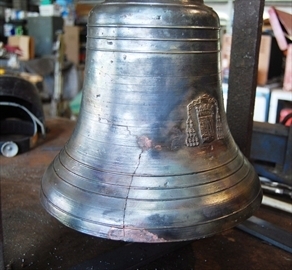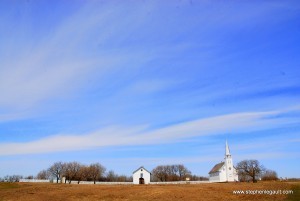Back to Batoche
Today is a momentous day for the Métis people of Canada, and for all Canadians. After 128 years the bell from the local church in the town of Batoche is coming home.
Stolen by soldiers from the Northwest Field Force on the final day of the battle that put Batoche on the map of Canadian history, the Bell ended up in the town of Millbrooke, Ontario, where it was housed in the local fire hall, until that building burned to the ground. Cracked in the fire, it was then put on display in the local Legion Hall. In 1991 the Legion was broken into and the bell ‘removed.’ It hasn’t been seen in public since.
The Union nationale métisse Saint-Joseph du Manitoba has now negotiated the bell’s return, promising anonymity with those who have held the bell for the last two decades. 
Today (Saturday July 20) is the day of the Bell’s repatriation.
In May of this year I visited Batoche for a second time. I was on a book tour for the Third Riel Conspiracy, a mystery novel set during the four day battle that was the climax of the 1885 Northwest Resistance. I had an event scheduled for Saskatoon that night, but wanted to see once again the landscape the Métis fought to defend.
Like too many Canadians, I didn’t learn about Batoche while I was in school. I learned more about the American Civil War than I did the events that indelibly shaped my own country. The Durrant Wallace series of historically themed mysteries are as much an excuse for me to dive deeply into my countries own past as it is a chance to tell compelling tales of intrigue and adventure.
While walking over the golden fields along the Mission Ridge, watching the Saskatchewan River bend between high bluffs where Métis sharpshooters kept the much more substantial Field Force at bay for four days, I thought that this was one of those places that every Canadian should step foot. Reading about the events that lead up to the Resistance is fine – the destruction of the buffalo, the deplorable starvation of the Cree, Sioux and Métis, the stolen land, the effort to force the Métis to accept land away from the River, lifeblood of the prairie, and of course religion – but walking the same pathways that Louis Riel and Gabriel Dumont did makes it real.
 At the center of the battle was the church. On the first and final day of the conflict, the fighting engulfed that building. That building creates a focal point for any visit to Batoche, and it was from there that the Bell was stolen, the spoils of war.
At the center of the battle was the church. On the first and final day of the conflict, the fighting engulfed that building. That building creates a focal point for any visit to Batoche, and it was from there that the Bell was stolen, the spoils of war.
As Canadians we still live in a nation divided. I’ve never condoned the tactics employed by Dumont and Riel in the spring of 1885, but I understand why a people, on the verge of starvation, their voices lost in the relentless crush of progress during that formative decade, would resort to any means necessary to get the attention of political Canada. Walking the trails at Batoche there is a feeling that Canada lost something important when both sides resorted to open warfare that spring.
Maybe, when the Bell rings out in Batoche once more, calling people not to pray but to consider our shared heritage and journey as a country, we can start to write a new chapter in our collective future together.



